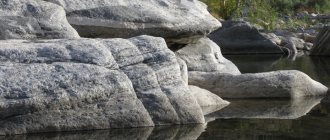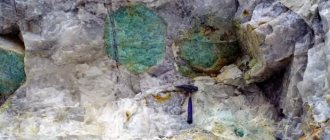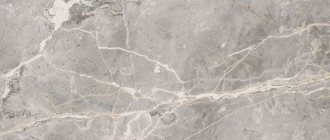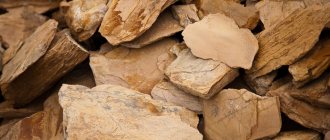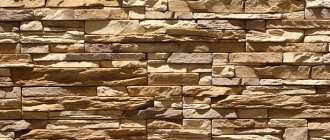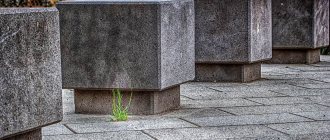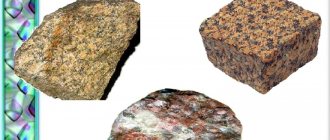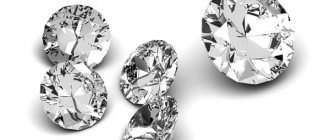Slate is a volcanic rock consisting of layers of minerals compressed under pressure and high temperatures, and the plates are easily divided. It cannot be argued that shale is an independent mineralogical unit with a single structure and chemical composition. Shale rocks contain many minerals that form and lie within them in layers.
Physico-chemical characteristics
In terms of composition, the shale rock is a conglomerate of metal oxides with a complex formula.
From half to three quarters of the composition is aluminum, almost a quarter is silicon. The remainder is divided into iron, calcium, magnesium, titanium, mica, and other impurities.
There is no single indicator for many characteristics of the rock (hardness scale, color, flammability, water permeability).
Varieties
The breed is diverse, so it was ordered by structure and composition.
All shales are divided into clayey and crystalline.
Clays are almost always dark gray or green. Compacted clay contains fragments of quartz, sulfur pyrites, rutile, feldspar, mica, and other minerals.
Based on their structure, description, and physical characteristics, the following types of shale are distinguished:
- Slate. A soft stone of gray shades, easy to flake. This is the core of ordinary pencils.
- Combustible. It looks like dense clay, easily ignites, and is in demand as fuel.
- Alum stone is saturated with sulfur pyrites.
- Siliceous. Dense multi-colored plates interspersed with quartz and chalcedony grains.
- Mica. A stone with mica and quartz as its main components. A special case is biotite shale (with black mica called biotite).
- Grinding. A greenish, very hard variety with a high percentage of silica.
- Chlorite. The main impurity - chlorine - creates green shades of stone with shine.
The durable layered texture has made black slate and gray roofing slate popular construction and technical materials.
A separate variety is considered to be a stone of artificial origin.
Places and methods of extraction
Oil shale deposits are being developed all over the planet. The largest reserves of stone are found in the USA, Brazil, the countries of Central Asia, Europe, Mongolia, and Belarus.
In Russia, stone is mined in Siberia, the Urals, the north of the European part of the country, and the North Caucasus.
Shale rock is extracted using two methods:
- open (in a quarry);
- underground.
The first is low-cost and environmentally friendly.
The second is cheap, but destroys the environment. Oil shale deposits are exploited as a source of cheap shale gas. In this case, the method of hydraulic fracturing is used. The technology is imperfect and harmful to the environment, therefore in many countries, including Russia, it is prohibited or not used for other reasons.
Construction of a slate roof structure
In principle, a roof covered with slate does not have any distinctive features. That is, it is a rafter system, a heat-insulating pie, a counter-lattice and a sheathing. The only thing is that when installing a slate roof, it is necessary to take into account the dimensions of the materials used. Namely, rafter legs. Their minimum cross-section: 75x200 mm. In this case, the installation pitch of the rafters should not be more than 80 cm, optimally 60-80 cm.
Slate roof rafter system Source th.decorexpro.com
See also: Catalog of companies that specialize in roofing materials.
As for the sheathing, under the slate roofing material it is necessary to lay either a solid sheathing or a loose sheathing with an installation step equal to half the length of the tile. This is due to the large weight of the material, and accordingly the large load on the roofing structure.
If the roof of the house will be constructed as an insulated structure, then it is better to lay a continuous sheathing under the slate. For this, a board 25 mm thick is usually used. But you can lay moisture-resistant plywood or OSB boards with a thickness of at least 20 mm. In this case, the slab material must be laid in a spaced pattern, preferably half a sheet. Please note that the larger the step between the rafter legs, the thicker the sheathing elements should be.
An interesting way to lay slate tiles. All roofing elements are laid overlapping relative to each other, thereby reducing the useful area of each element. For example, the photo below shows how slate dies are placed on the roof.
Location of slate tiles on the roof structure Source www.roofmaster.ru
Therefore, it is very important to accurately calculate the required amount of roofing material. For information, let's give a simple example. Dimensions of the roof to be covered with slate: length 5 m, width 3 m. Tiles measuring 30x60 cm are used for the covering. It must immediately be noted that the width of the tiles is overlapped with an offset of 10 cm, and the length - 15 cm. That is, the useful area of the tiles will be : 20x45 cm.
Now let's do the calculation:
- number of slate dies in one row : 500/45 = 11.1, rounded up to 12 rounds;
- number of rows : 300/20=15 rows;
- Now the two obtained values must be multiplied together , the required amount of roofing material is obtained: 15x12 = 180 pieces.
Correct calculation of the number of tiles is the key to saving Source wizmag.ru
Where is it used?
Slates are in demand by industry, decorators, and stone cutters. The scope of application is determined by the characteristics of the raw materials.
Industry
Oil shale is a source of hydrocarbons and raw material for the chemical industry. They are easy to distinguish by their gray-yellow to black shades and low density.
Natural crystalline slate is used as a building material that requires minimal processing.
The stone is valued for many properties:
- Reliability. Walls and roofs made of slate can last for decades. If the installation technology is followed, the roof will not leak or crawl. The mineral is indifferent to natural disasters, temperature changes, heat, cold, and corrosion.
- Houses made of fire-resistant slate are completely fireproof.
- Aesthetics. Slate coating does not “shed” from rain or sun.
Slate (especially crystalline) retains heat, which is of particular importance in regions with harsh climates. And the stone muffles noise just as well.
Decor
Designers love stone for its variety of shades, textures, and texture.
Artificial slate
Decorative stone slate becomes a tabletop in the interior, cladding walls, floors, fireplaces, stoves, and large architectural forms. It looks noble and is beneficial because it retains warmth and privacy.
Slate in the interior
In landscape design these are paths, paths, alpine slides, garden and house compositions.
Other areas
Dishes and items with esoteric themes are made from slate.
And also pendants, bracelets, beads. This decoration is suitable for youth, ethnic, boho and similar clothing styles. You can minimally care for the stone.
Origin of shale
The history of shale formation goes back at least 300 million years. Most deposits were formed during the process of volcanic changes in the bowels of the earth or on the seabed from settled silt and clay, which under the pressure of mountain ranges or water were transformed into thin layered layers.
The basis of the shales is composed of dark-colored minerals with inclusions of feldspars or quartz. Some varieties of rock (for example, mica schists) contain mica.
Artificial slate
Artificial slate is made from gypsum, cement, and other materials plus dyes. It is also rich in color palette and resistant to external influences. Much cheaper than natural ones.
But there are disadvantages. For example, gypsum stone is suitable only for interior decoration and dry rooms: gypsum quickly absorbs moisture and swells. It is not used for roofing or as facade material.
Man-made stone can be distinguished visually: it lacks the patterning created by plates of natural slate.
Magic properties
Sorcerers use slate as an oracle-predictor and a channel of communication with the inhabitants of the other world.
The magical properties of slate are also useful in everyday life:
- The stone acts as an amulet against external negativity.
- Helps to get out of a difficult, sticky situation.
- Accelerates the implementation of plans and achievement of goals.
- It is worn to make it easier to survive emotional turmoil and loss.
Talismans made of green stones attract money.
The magic of the mineral makes a person lucky.
Installation instructions
Installation process:
- Prepare the surface: remove the old coating, level, wash off dirt, degrease.
- Dilute the tile adhesive in such a volume that the finished solution is consumed within 15–20 minutes.
- The tiles are laid in a seamless manner, with each element placed at a minimum distance from each other. Remaining glue is immediately removed. When installing seamlessly, it is necessary to ensure that the glue extends to the ends of the elements without getting on the front part.
- Laying begins with corner elements, short and long tiles alternate. To create support, the cladding is carried out from the bottom up. Once the glue in the bottom layer has dried, you can begin further installation.
- To ensure that the masonry retains its properties and appearance, it is coated with finishing impregnation. It is applied to a previously cleaned tiled wall.
Important
The air temperature in the room where installation is carried out should be from -5 to +30 degrees.
Therapeutic effect
Energetically strong shale creates a positive effect on human health:
- The stone calms the nerves, eliminates stress, tension, apathy, and anger.
- The heated mineral is applied to the site of a cut, inflammation, or wound to speed up healing.
- The stone can be left in clean water overnight. And in the morning drink it as a preventative or cleansing agent for the body.
- For healthy, calm people, the stone is useful as a guarantor of maintaining physical and mental health.
Slate is a talisman-assistant to creative and artistic people.
Knowledgeable people recommend tiling at least one room in a house or apartment with slate. Health will improve, emotions will be under control.
How to use a slate roof
It is very important in the first years of operation of a roof covered with slate to constantly monitor its technical condition. The thing is that the natural shrinkage of the house slightly deforms the roof structure. And although a gap is left between the fasteners and dies, there is always the possibility that some elements of the roofing will be subject to heavy loads. And this can lead to their breaking or cracking.
Therefore, it is always necessary to inspect the roof and identify defective tiles or entire areas that will become leaks. And this cannot be allowed.
By the way, repairing a roof covered with slate tiles is not difficult. If the defects are small, they are usually filled with silicone sealant. If there is a need to change one or more dies, then the copper nails of the defective elements are cut off, the tiles are removed, and new ones of exactly the same shape and size are installed in their place.
Price
In Russian online stores you can buy construction materials, collection materials, and other products (price, rub.):
- ax (gift for a man) – 11,200;
- figurine (210x70 mm) – 1,200;
- cabochon (pyrite in slate, 44x25x5 mm) – 510.
There is a wide range of building materials. And the price depends on the place of extraction and the manufacturer.
Domestic facing tiles will cost 450-850 (m2). The cost of imported, for example, from the Brazilian breed, is from three thousand rubles.
Installation of slate covering
First of all, you need to decide on the configuration of the location of the slate tiles. There are several options, which depend on the shape of the roofing material itself. Here are some styling options.
German way
This option is often called “wild masonry.” The bottom line is that to cover the roof with this technology, you can use dies of different sizes and shapes. This is a very complex method of forming a roof covering, because you have to adjust the elements to each other, creating an impenetrable plane on the roof. And this increases the cost of the work carried out.
German technology for laying slate tiles Source germes.by
English way
Usually, either square dies, or rectangular ones, or one or the other with a rounded edge are used for this. They are arranged in even rows, with each subsequent row being laid offset relative to the elements of the previous one. The rows are laid horizontally, each element of the roofing is laid with an overlap, both horizontally and vertically.
English technology for laying slate tiles Source evo-roof.ru
French way
This is the most beautiful slate roofing structure, because the tiles are laid with a sharp angle upward, regardless of whether the bottom angle of the tiles is pointed or rounded. That is, the tiles are arranged exactly like this. At the same time, only square elements are required for a French roof. This is the most difficult installation option, requiring experience in carrying out this type of work. It is very important to shape the roof ridge. To do this, the tiles on one of the slopes are laid so that they protrude above the ridge, and, accordingly, above the plane of the second slope. After the formation of two slopes, the gap between the tiles is sealed with a sealing compound.
French technology for laying slate tiles Source junior3d.ru
Which option to choose is up to everyone to decide for themselves. But at the same time, it is necessary to take into account the architecture of the house itself.

